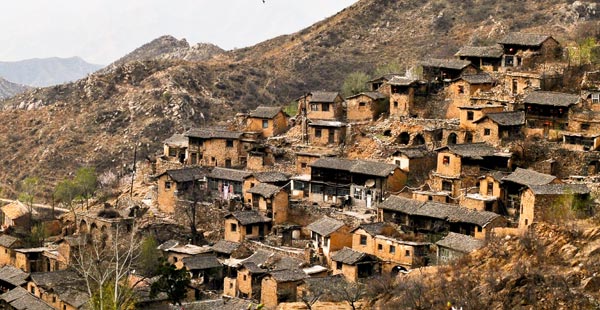Turn back the clock
 |
|
Dachang village in Yuxian county, Shanxi province, is known for its nearly 100 two-story houses perched on a steep slope.[Photo by Liu DeJun/China Daily] |
A visit to the rustic village of Dachang is like traveling back in time. Li Yang takes you on a journey through the ages to Yangquan, Shanxi province.
Time freezes in Dachang, a 1,000-year-old village in Yuxian county of Shanxi province. The same can be said about the lives of the 16 villagers, two cats, one dog, some 30 chickens and 70-plus goats.
But after China Central Television broadcast a documentary film on Dachang one year ago, hundreds of travelers, painters and photographers flocked to the once obscure spot.
"Simplicity is the nature of life and happiness," a traveler from Beijing says, sighing satisfactorily after staying in Dachang for a week. But there are also others who returned disappointed after a two-hour visit.
The village's nearly 100 two-story buildings, made of local wood, bricks, tiles, stones and mud, are well positioned on a steep slope of the Taihang Mountain range, with their facades facing the southern valley.
There are no other signs of human life within four hours' trudge over the bumpy dirt path in the droughty mountains. The village sticks out against the surrounding desolation.
The village's buildings, which are different from the one-story flat-roof houses in Shanxi, were built by the descendants of an official family in the Song Dynasty (960-1279) who fled from wars in South China and settled on the mountain slope rich with spring water.
Photographers and painters compare the village to the looks of the Potala Palace on a mountain slope in Lhasa of the Tibet autonomous region.
"It looks the best after snow or in dusk or dawn, when the changing of light enriches the layers of the view and welds the mud-yellow village to the earth-tone mountain slope," says a watercolor painter from Tianjin.
There were more than 300 people in Dachang during its prime in the late 1970s, living on potatoes, grains and carrots planted in meager plots. After the reform and opening-up of China in 1978, young people started migrating to cities, leaving only 16 villagers ages 65 to 90.
"They simply do not want to move to live with their children in cities," says Han Guoyin, the 50-year-old former village head.
"They take care of each other and lead self-sufficient lives. Their children usually give them some money through me."
Han drives his motor-tricycle to deliver daily necessities to Dachang every two weeks.


















